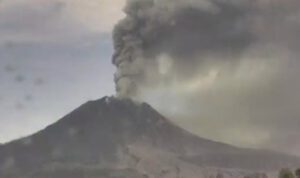 On Sumatra the Sinabung volcano continues to erupt volcanic ash. In light winds the eruption cloud rises up to 5200 m above sea level. Yesterday, local volcanologists recorded 20 seismic signals, 1 of which was due to an eruption. Today they recorded 6 seismic signals in the first quarter of the day, which were related to the ash emissions. Only one quake was of tectonic origin. There was also a tremor phase. Overall, the seismic activity can be described as moderate and only a few magmatic fluids are moving underground. No dome growth has been reported so far, but it could start in the medium term.
On Sumatra the Sinabung volcano continues to erupt volcanic ash. In light winds the eruption cloud rises up to 5200 m above sea level. Yesterday, local volcanologists recorded 20 seismic signals, 1 of which was due to an eruption. Today they recorded 6 seismic signals in the first quarter of the day, which were related to the ash emissions. Only one quake was of tectonic origin. There was also a tremor phase. Overall, the seismic activity can be described as moderate and only a few magmatic fluids are moving underground. No dome growth has been reported so far, but it could start in the medium term.
Eruptions
News about eruptions and volcanoes can be found in this category. It is updated frequently. Volcano expert and journalist Marc Szeglat reports live from his expeditions to volcanoes.
Etna still ashes
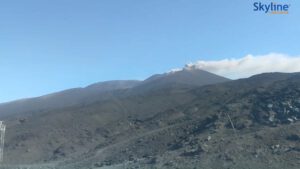 In Sicily, Etna is still active and emits volcanic ash. Strong wind pushes the ash down and blows it into the Valle del Bove, which is located in the east of the volcano. The tremor fluctuates strongly and moves in medial-high spheres. Earthquake activity has not been particularly high in the last 2 days. However, several weak earthquakes occurred below the central crater area on August 14th. It should be noted that the INGV often reports earthquakes with a 1-2 day delay. On the thermal cam you can see that not only the saddle vent of the New South East Crater cone is involved – from which the volcanic ash is emitted – but also the actual main crater of the NSEC. A weak thermal signal is emitted from it and it looks as if hot volcanic scoria or hot fumaroles have been deposited at the crater rim.
In Sicily, Etna is still active and emits volcanic ash. Strong wind pushes the ash down and blows it into the Valle del Bove, which is located in the east of the volcano. The tremor fluctuates strongly and moves in medial-high spheres. Earthquake activity has not been particularly high in the last 2 days. However, several weak earthquakes occurred below the central crater area on August 14th. It should be noted that the INGV often reports earthquakes with a 1-2 day delay. On the thermal cam you can see that not only the saddle vent of the New South East Crater cone is involved – from which the volcanic ash is emitted – but also the actual main crater of the NSEC. A weak thermal signal is emitted from it and it looks as if hot volcanic scoria or hot fumaroles have been deposited at the crater rim.
Kadovar emits ash
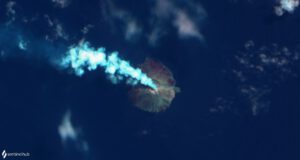 In Papua New Guinea the Kadovar volcano has become more active again. The small island volcano emits volcanic ash, which rises to an altitude of 1500 m. The volcano has been active again and again since January 2018, with major eruptions that changed the face of the island. For example, a lava dome grew on the east coast, which caused concern that it might collapse, causing a tsunami. Also this year, there were some bigger eruptions, but most of them took place under exclusion of the world public. Before the eruptions began, there was a small settlement on Kadovar. This was abandoned in the meantime and the inhabitants were resettled.
In Papua New Guinea the Kadovar volcano has become more active again. The small island volcano emits volcanic ash, which rises to an altitude of 1500 m. The volcano has been active again and again since January 2018, with major eruptions that changed the face of the island. For example, a lava dome grew on the east coast, which caused concern that it might collapse, causing a tsunami. Also this year, there were some bigger eruptions, but most of them took place under exclusion of the world public. Before the eruptions began, there was a small settlement on Kadovar. This was abandoned in the meantime and the inhabitants were resettled.
Etna is getting hotter
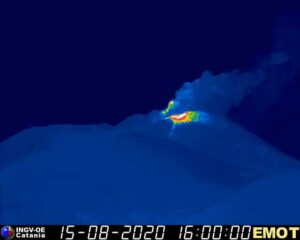 After ash emissions stopped yesterday afternoon, the volcano has resumed its activity today. Indeed, on the thermal cam you can see that the area around the saddle vent is hot and glowing tephra is being extracted. Ash is caught by the strong wind, pressed down and transported towards the northeast. The tremor fluctuates strongly at the border to the “red area”. The LGS maintains the pre-warning level “orange”. It already indicated an increase in activity 3 days ago. Under the Valle del Bove the number of weak earthquakes increased slightly again. Earthquake activity below the summit crater is unremarkable.
After ash emissions stopped yesterday afternoon, the volcano has resumed its activity today. Indeed, on the thermal cam you can see that the area around the saddle vent is hot and glowing tephra is being extracted. Ash is caught by the strong wind, pressed down and transported towards the northeast. The tremor fluctuates strongly at the border to the “red area”. The LGS maintains the pre-warning level “orange”. It already indicated an increase in activity 3 days ago. Under the Valle del Bove the number of weak earthquakes increased slightly again. Earthquake activity below the summit crater is unremarkable.
Sinabung erupted
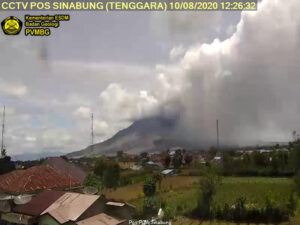 On the Indonesian island of Sumatra the Sinabung erupted again. The VAAC Darwin published a VONA message, after which volcanic ash rose to a height of 9800 m. The cloud drifted in a westerly direction. In time a second cloud reached a height of 4200 m and was multiplied in eastern direction.
On the Indonesian island of Sumatra the Sinabung erupted again. The VAAC Darwin published a VONA message, after which volcanic ash rose to a height of 9800 m. The cloud drifted in a westerly direction. In time a second cloud reached a height of 4200 m and was multiplied in eastern direction.
The volcanologists of Magma/VSI registered increased seismic activity the day before. Among the signals was a Tornillo. They detected the eruption in 2 signals with maximum amplitudes of 120 mm and 1785-2246 seconds duration. Although the eruption cloud rose higher than during the last eruption, there must not have been a much higher energy behind it. Weaker winds may have favoured the vertical rise of the volcanic ash to higher altitudes. The seismic signals indicate an eruption similar to the one on 8 August. In fact, the main eruption lasted longer than now.
The seismicity was increased in the first quarter of the day. There were 19 volcano-tectonic tremors recorded. Another Tornillo was also recorded. Tremor also occurred. In fact, it looks like the sinking has entered a new eruptive phase.
Erupsi #Sinabung 10 Agustus 2020 10.16WIB https://t.co/TuGNOVdDhe pic.twitter.com/EcTnTeSzxF
— MAGMA Indonesia (@id_magma) August 10, 2020
Iceland: inflation confirmed
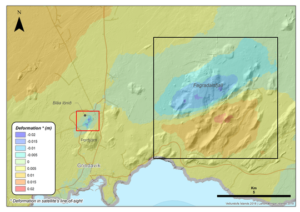 The IMO confirmed the presumed inflation in the earthquake zone near the Fagradalsfjall volcano on the Reykjanes peninsula. The ground elevation has been 3 cm since the beginning of the swarm earthquake on 18 July. The magma inflation was detected by INSAR satellite images. The deformation took place mainly during the main phase of the quake activity between July 18th and 20th. The magma penetrated into a northeast-southwest striking fault zone, which was already discovered in 2017, when swarm quakes also occurred there. The deformation is considered part of a larger volcanic-tectonic reactivation event on the Reykjanes Peninsula. This not only results in ground uplift, but also in subsidence. Such subsidence has now been discovered in the area of the Svartsengi geothermal power plant. It started 2 days before the swarm earthquake at Fagradalsfjall and was probably caused by the underground run-off of magmatic fluids.
The IMO confirmed the presumed inflation in the earthquake zone near the Fagradalsfjall volcano on the Reykjanes peninsula. The ground elevation has been 3 cm since the beginning of the swarm earthquake on 18 July. The magma inflation was detected by INSAR satellite images. The deformation took place mainly during the main phase of the quake activity between July 18th and 20th. The magma penetrated into a northeast-southwest striking fault zone, which was already discovered in 2017, when swarm quakes also occurred there. The deformation is considered part of a larger volcanic-tectonic reactivation event on the Reykjanes Peninsula. This not only results in ground uplift, but also in subsidence. Such subsidence has now been discovered in the area of the Svartsengi geothermal power plant. It started 2 days before the swarm earthquake at Fagradalsfjall and was probably caused by the underground run-off of magmatic fluids.
Raung with Hotspot
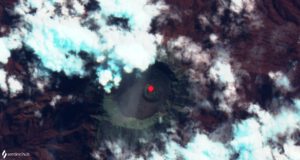 The volcano Raung is located in the east of the Indonesian island of Java and has been under special observation by local volcanologists for several days. Seismic signals signalled the awakening of the volcano. Small ash clouds were also sighted rising above the crater rim. Now there is a further indication of the increasing activity of the volcano: the sentinel satellites detected a heat source. It emits radiation with a power of 33 MW and is located at the northern rim of the small crater that had formed in the caldera in 2015. The crater is part of an intra-caldera cinder cone. The evidence suggests strombolian activity. Visual observations of the crater rim have not been reported to me. Raung is part of the Ijen volcanic massif, which also includes the better known sulfur-producing Kawah Ijen.
The volcano Raung is located in the east of the Indonesian island of Java and has been under special observation by local volcanologists for several days. Seismic signals signalled the awakening of the volcano. Small ash clouds were also sighted rising above the crater rim. Now there is a further indication of the increasing activity of the volcano: the sentinel satellites detected a heat source. It emits radiation with a power of 33 MW and is located at the northern rim of the small crater that had formed in the caldera in 2015. The crater is part of an intra-caldera cinder cone. The evidence suggests strombolian activity. Visual observations of the crater rim have not been reported to me. Raung is part of the Ijen volcanic massif, which also includes the better known sulfur-producing Kawah Ijen.
Stromboli: Another strong explosion
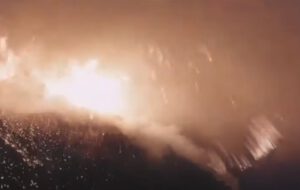 The Italian volcano Stromboli once again proved its unpredictability tonight and erupted a large amount of tephra at 3 o’clock, which covered the entire summit area with glowing bombs. On the video embedded below you can see that it was a short eruption phase with 4 explosions. At least 2 winding vents were involved in the explosions. Such unusually strong eruptions occurred in the past and cost the lives of several volcano observers. This time, however, no people should have been in the summit area, because the ascent was still blocked. Local residents report that they were woken up by a loud bang. However, no material fell in the lower part of the volcano. The eruption was weaker than on 3 July last year.
The Italian volcano Stromboli once again proved its unpredictability tonight and erupted a large amount of tephra at 3 o’clock, which covered the entire summit area with glowing bombs. On the video embedded below you can see that it was a short eruption phase with 4 explosions. At least 2 winding vents were involved in the explosions. Such unusually strong eruptions occurred in the past and cost the lives of several volcano observers. This time, however, no people should have been in the summit area, because the ascent was still blocked. Local residents report that they were woken up by a loud bang. However, no material fell in the lower part of the volcano. The eruption was weaker than on 3 July last year.
Unlike last year’s two eruptions, there was no longer period of increased activity before. On the contrary, the eruptions of the past days were comparatively weak. Only a few hours before, the strombolian eruptions increased significantly. Images of these were shared in our FB group “volcanoes and volcanism“. The only indicator for magma rise was an increased carbon dioxide emission: in the last two days the daily production increased from less than 200 tons to almost 1000 tons. Already at the end of June there were 2 measurements of more than 1000 tons per day.
Raung: Eruption started
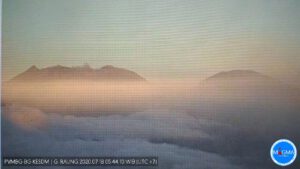 On the Indonesian island of Java, the volcano Raung has started an eruption. The eruption was preceded by a seismic crisis. It started on July 13th. The first small ash cloud was detected 2 days ago. A VONA warning was issued and air traffic on the neighbouring island of Bali was suspended. However, due to the corona lockdown, only very few flights may have been affected. In the meantime a stable eruption on a low level has occurred. During the first 6 hours of the day, volcanologists from VSI recorded 28 seismic eruption signals. They had amplitudes between 4 and 14 mm and lasted up to 150 seconds. MIROVA recorded a moderate thermal anomaly with peak values of 15 MW. One can assume strombolian activity, where glowing tephra accumulates in the crater. The alert status has been raised to “yellow.”
On the Indonesian island of Java, the volcano Raung has started an eruption. The eruption was preceded by a seismic crisis. It started on July 13th. The first small ash cloud was detected 2 days ago. A VONA warning was issued and air traffic on the neighbouring island of Bali was suspended. However, due to the corona lockdown, only very few flights may have been affected. In the meantime a stable eruption on a low level has occurred. During the first 6 hours of the day, volcanologists from VSI recorded 28 seismic eruption signals. They had amplitudes between 4 and 14 mm and lasted up to 150 seconds. MIROVA recorded a moderate thermal anomaly with peak values of 15 MW. One can assume strombolian activity, where glowing tephra accumulates in the crater. The alert status has been raised to “yellow.”
The last eruptions of the Raung occurred in 2015, when the eruptions started like now and increased within a few weeks to a very interesting eruption, where not only strombolian eruptions were generated, but also lava flows that filled part of the crater.
Nishinoshima grows
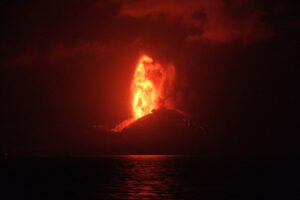 The Japanese volcanic island of Nishinoshima is growing and growing and is not only producing lava flows but also ash clouds. On 13. July these reached an altitude of 6100 m, with a cone height of 200 m.The Japanese coast guard photographed lava fountains that were as high as the cinder cone. Today the activity seems to be decreasing. The VAAC recorded volcanic ash at an altitude of 3700 m.
The Japanese volcanic island of Nishinoshima is growing and growing and is not only producing lava flows but also ash clouds. On 13. July these reached an altitude of 6100 m, with a cone height of 200 m.The Japanese coast guard photographed lava fountains that were as high as the cinder cone. Today the activity seems to be decreasing. The VAAC recorded volcanic ash at an altitude of 3700 m.
New observations will be made on July 20 by the meteorological observation ship “Keifu”.